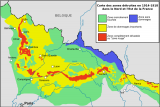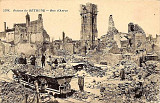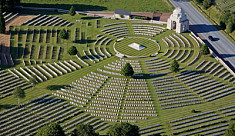Contents
By 1918 four years of trench warfare had turned a vast expanse of France, spreading from north to south across the departments of Nord and Pas-de-Calais (along a line which took in the towns of Armentières–Lens–Arras–Bapaume), into a wasteland. Millions of shells had churned up the soil, hacked down the trees and reduced to rubble, even obliterated, whole villages and towns such as Armentières and Lens. This was the "red zone" where the once fertile land had been transformed into a barren landscape characterized by heaps of debris, shattered communications and jagged tree stumps.
The population of Northern France was confronted by two pressing problems: the proper burial of the hundreds of thousands of soldiers of all sides who had died in the fighting and the clearing up of the wreckage. Then, and only then, could they begin to rebuild their devastated region. The first of these vital tasks was to provide a reliable supply of drinking water because almost all of the region's wells had been destroyed or spoiled and its natural springs disrupted. Temporary shelters also had to be built, either in wood recovered from the ruins or with materials provided by the armies. And then there was the question of the refugees who had fled the region during the war. The authorities began to organize their return in 1919, a process which would take a number of years.
Operations to clean up the battlefields took five years. Barbed wire entanglements and many other sorts of military obstacles had to be taken down and unexploded bombs defused and removed. For the department of Pas-de-Calais alone 178,000 hectares had to be cleared of military waste before the ground could be levelled off and the rubble dealt with. The size of the task was particularly daunting in the "red zone", a wasteland of 26,409 hectares spread over forty-six districts in the department of Pas-de-Calais.
The law of 17 April 1919 ruled that the French state was responsible for the repair of the damage caused by the war. Thenceforth it agreed to purchase any land in the red zone which had been written off, that is to say the cost of rehabilitating it being greater than its market worth. It also fell to the French state to reinstate the land registry and re-establish property boundaries. An official body, drawing on the work of district committees, was set up in Arras in March 1919 to manage the redivision of the affected land. Most of the devastated districts voted for real estate to be restored to its former boundaries despite the French authorities favouring a logical reorganization of the land. Work to measure the land and mark out property boundaries was completed, for the most part, by 1923. Although the financial, administrative and technical aid provided by the French authorities was considerable, the restoration of agricultural land would never have been completed as quickly as it was (it took about ten years) without the work put in by the farmers themselves.
The colossal scale of the Reconstruction led, inevitably, to the application of industrial techniques. Reinforced concrete, today ubiquitous on building sites, was used to provide the main structure of public buildings and in rural areas red clay bricks replaced white limestone, changing forever the colour of the region's villages...
Yves LE MANER,
Director of La Coupole
History and Remembrance Centre of Northern France
Archive pictures

Tinodela / Wikimedia Commons (png - 0.15 MB)
Carte des zones détruites durant la Première Guerre mondiale dans le Nord et l'Est de la France

coll. particulière (jpg - 0.17 MB)





